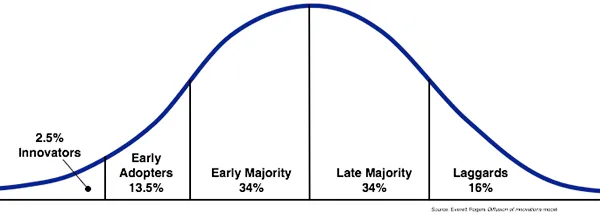How People React to New Software
Table of contents

People take to software in different ways at different speeds so a successful software implementation requires flexibility, creativity, and humanity.
Related
- Getting Users to Actually Use Your Workflow System
- The New Rules for Change Management
- You’re Ready for That Huge Project
Change.
That one word strikes fear in the hearts of a good percentage of employees at your company. Yet businesses cannot move forward without it. Being willing to change is one trait that successful companies share. But change done well includes an understanding of how to manage that change.
In other words, a corporate willingness to change only succeeds when employees from all corners are led properly into that change.
As software project managers, rolling out a new piece of software is only a small part of your responsibilities. You also need your software project to succeed in terms of adoption, acceptance, and utilization. Yet you may lack formal experience or education in business training. You may feel like you’re flying blind when it comes to helping others adapt to new software.
If you’re a software project manager, this article is for you. The same goes for department managers and anyone else who ends up needing to help employees adapt to new software. Below, we’ll explore some of the psychology of change management. You’ll better understand the various ways people approach change generally as well as how that plays out in new software rollouts.
One Size Doesn’t Fit All
If you take only one thing away from reading this, here it is: with new software rollouts, one “size” doesn’t fit all. People have different relationships with technology, and their training needs are not monolithic. If you, as a project manager, trainer, coach, boss take one training approach for everyone, you’re not likely to succeed with everyone.
The Technology Adoption Lifecycle
There’s some excellent research already done(opens in a new tab) that applies quite well to the ways that people react to new software. You’ll see it described in several ways, but we’ll just call it the technology adoption lifecycle. This widely used model divides a group (in this case, your workforce, business, or department) into five categories. It also estimates the percentage of people in your group that will fall into each, along a bell curve.
- Innovators (2.5%)
- Early Adopters (13.5%)
- Early Majority (34%)
- Late Majority (34%)
- Laggards (16%)

This model was initially developed in the 1950s with a focus on agricultural practices and technology, but it has been widely used in management and business applications ever since, even in sales and digital marketing. In its original context, the categories work like this.
Innovators
Innovators are a small group at the forefront of change. They are willing to experiment with unproven solutions and even invent their own.
Early Adopters
Early Adopters are watching the innovators and industry developments. They are quick to jump on new solutions, but not as risk-happy as the Innovators.
Early and Late Majority
The Early and Late Majorities include, well, the majority of people. They want to see increasingly more evidence that new technology is going to help them before using it.
Laggards
Laggards are change-averse. They wait to the last possible moment to adopt something new, and they often miss out on the advantage of that technology for some time.
Below, we’ll explore the lasting value of these categories applied to software rollouts.
Applying the Technology Adoption Lifecycle to New Software Rollouts
A technology adoption lifecycle is a robust tool, but it does require a little modification (or at least understanding) when we apply it to software rollouts. In the original system, individuals got to decide when to implement new technology. That’s not how software rollouts work.
We can also lump Innovators and Early Adopters together. We can do the same for both Majority categories. This leaves us with three big categories. Let’s explore how these categories tend to react to new software and how you can help each category succeed.
Innovators and Early Adopters
In terms of new software, your Innovators are the ones that emailed you a year ago, pressuring you to switch to this (or another) solution. They are invested, and they care. They probably know the software better than you. If not, they will learn it faster than you.
Early adopters are a less extreme version of this. They probably have heard of your new solution even before it gets mentioned company-wide. They are self-motivated and will learn the ins and outs of the software on their own, very quickly. Combined, Innovators and Early Adopters make up less than 20% of your group.
Key Terms : Partnership and Governance. With innovators and early adopters, you won’t have to do much by way of change management or “this is how you use it” sorts of training. The real key is going to be governance. This group is going to find stuff your software can do that isn’t helpful across the organization. They’re going to find five separate ways to complete a task.
Form a partnership and learn from these people where they find truly better ways to operate. At the same time, set clear governance so that they know what sorts of areas or functions they should and shouldn’t use.
Early and Late Majorities
Together, the Early and Late Majorities are almost 70% of your group or workforce. This is a massive group, and it can make or break your success based on size alone. Together, the Majorities represent a wide range of attitudes to new technology. Most will learn the bare minimum, following whatever standard training manual or PDF they are given. They will learn exactly what they need to function, but not much more. This is a range, of course: some will go a little beyond this, and others will be timid, barely approaching this level.
Key Terms : Clarity and Empowerment(opens in a new tab). This large category needs clarity. Don’t rely on the user manual that comes from the software manufacturer. Develop a static, custom resource that clearly explains the software functions that this group needs to use. If multiple departments use the software in differing ways, you may want to produce multiple guides.
You also want to empower this group. On the far end of this group, you have people that still don’t know keyboard shortcuts for “copy” and “paste.” A little extra empowerment effort can make these people far more productive.
Laggards
The remaining 16% of your group is just plain technologically averse. Though few in number, these employees can sink a rollout or even get left behind to the degree that they can no longer function well. Understand that these people usually aren’t willfully sabotaging you. They are genuinely anxious about this change, and they may lack basic training or familiarity that other groups have. They need the most attention.
Summary
Even the best, most useful software in the world can end up dusty in the corner if not rolled out correctly. By addressing your end-users as unique individuals with their own concerns and expectations, you can implement your new software efficiently and effectively while experiencing a better return on your investment.








